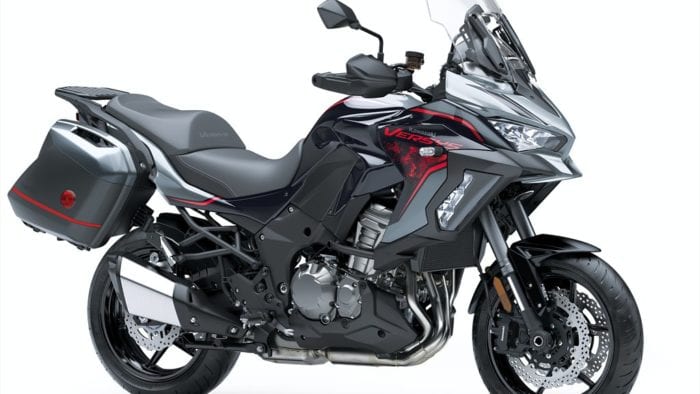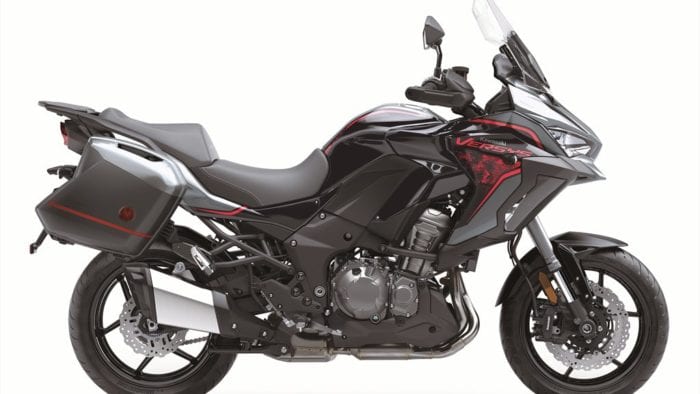The 2021 Kawasaki Versys 1000 SE is an Adventure Tourer With the Heart of a Sportbike
Contents
The 2021 Kawasaki Versys 1000 ABS SE LT+ is the highest spec adventure bike from the venerable Japanese manufacturer. The engine of the bike, a 1,043cc inline-four, is shared with the friendly and easy to ride Ninja 1000 ABS. In both bikes, it produces 118 HP and 75 lb-ft of torque. The biggest difference between the two is engine mapping, where the sportbike is aiming for high revving power, while the adventure tourer wants low-and-mid-range grunt.
Being Kawasaki’s flagship model, it seems that they threw in everything, including a kitchen sink. Cornering stability control, traction control, variable riding and power modes, electronic cruise control, electronically adjustable suspension, and the aforementioned kitchen sink are all standard. Also standard are Kawasaki’s Hard Luggage System with KQR snap-in mount points.
The one new addition to the 2021 model is the inclusion of Kawasaki Skyhook. This is a selectable ride mode, or will automatically activate in certain other ride modes, that if a very rough or bumpy surface is detected, the bike will automatically adjust the suspension to smooth out as much of the rough ride as possible.
The 2021 Kawasaki Versys 1000 ABS LT SE+ starts at $18,199 USD / $20,099 CAD.
On this page: we’ve curated specs, features, news, photos/videos, etc. so you can read up on the new 2021 Kawasaki Versys 1000 SE LT+ in one place.
Model Overview
General Info
- Price: $18,199 USD / $20,099 CAD
- Key Features:
-
- Very few options as most items come standard on this flagship model
- Sportbike-derived inline-four gives excellent power and torque
- Kawasaki Skyhook ride system
Main Specs
- Engine Type: 1,043cc 4-stroke, DOHC, 16-valve, liquid-cooled inline-four
- Horsepower: 118 HP
- Torque: 75 lb-ft
- Wet Weight: 567 lbs (257 kg)
- Seat Height: 33.1 inches (840 mm)
Competitors
- KTM 1290 Super Adventure R
- Yamaha Super Tenere ES
- Suzuki V-Strom 1050XT
2021 Kawasaki Versys 1000 SE LT+ Specifications
ENGINE |
||
| Engine | 1,043cc 4-stroke, DOHC, 16-valve, liquid-cooled inline-four | |
| Power | 118 hp | |
| Bore x Stroke | 77.0 x 56.0mm | |
| Compression Ratio |
10.3:1
|
|
| Fuel System | DFI® with 38mm Keihin ETV throttle bodies (4) | |
| Starter | Electric | |
| Lubrication | ||
DRIVETRAIN |
||
| Clutch | ||
| Transmission | 6-speed, return shift, Kawasaki Quick Shifter (KQS) | |
| Final Drive | Sealed chain | |
CHASSIS |
||
| Suspension Front | 43mm inverted fork with KECS-controlled rebound and compression damping, manual spring preload adjustability and top-out springs/5.9 in | |
| Suspension Rear | Horizontal back-link New Uni-Trak®, BFRC gas charged shock with piggyback reservoir, KECS-controlled compression and rebound damping electronically-adjustable spring preload/5.9 in | |
| Brakes Front | Dual 310mm petal-style discs with four-piston calipers, ABS | |
| Brakes Rear |
Single 250mm petal disc with single-piston caliper, ABS
|
|
| Tires Front | 120/70 ZR-17 | |
| Tires Rear | 180/55 ZR-17 | |
| Fuel Tank Capacity | 5.5 gal | |
| Color |
Pearl Storm Gray/Metallic Diablo Black/Metallic Flat Spark Black
|
|
ELECTRICAL |
||
| Ignition | TCBI with electronic advance | |
| Spark Plugs | ||
| Headlight | LED | |
| Tail Light | LED | |
DIMENSIONS |
||
| Overall Length | 89.4 in | |
| Overall Width | 37.4 in | |
| Overall Height | 58.7 in/60.2 in (windshield down/up) | |
| Wheelbase | 59.8 in | |
| Ground Clearance | 5.9 in | |
| Seat Height | 33.1 in | |
| Curb Weight | 566.7 lb (+ Saddlebags, Hand Guards, & Hardware approx. 20 lb.) | |
WARRANTY |
||
| Warranty | 12 Month Limited Warranty | |
| Kawasaki Protection Plus | 12 / 24 / 36 / 48 months | |
2021 Kawasaki Versys 1000 SE LT+ Features
Assist & Slipper Clutch
Under normal operation, the assist cam functions as a self-servo mechanism, pulling the clutch hub and operating plate together to compress the clutch plates. This allows the total clutch spring load to be reduced, resulting in a lighter clutch lever feel when operating the clutch.
When excessive engine braking occurs – as a result of quick downshifts (or an accidental downshift) – the slipper cam comes into play, forcing the clutch hub and operating plate apart. This relieves pressure on the clutch plates to reduce back-torque and helps prevent the rear tire from hopping and skidding. This race-style function is particularly useful when sport or track riding.
Economical Riding Indicator
While effective vehicle speed and engine speed may vary by model, paying attention to conditions that cause the “ECO” mark to appear can help riders improve their fuel efficiency – a handy way to increase cruising range. Further, keeping fuel consumption low also helps minimize negative impact on the environment.
Dual Throttle Valves
On models with dual throttle valves, there are two throttle valves per cylinder: in addition to the main valves, which are physically linked to the throttle grip and controlled by the rider, a second set of valves, opened and closed by the ECU, precisely regulates intake airflow to ensure a natural, linear response. With the air passing through the throttle bodies becoming smoother, combustion efficiency is improved and power is increased.
Electronic Cruise Control
Electronic Throttle Valves
Electronic throttle valves also enable more precise control of electronic engine management systems like S-KTRC and KTRC, and allow the implementation of electronic systems like KLCM, Kawasaki Engine Brake Control, and Electronic Cruise Control.
KTRC (Kawasaki Traction Control)
Less intrusive modes maintain optimum traction during cornering. Designed with sport riding in mind, they facilitate acceleration out of corners by maximizing forward drive from the rear wheel. And because Kawasaki’s sophisticated software bases its dynamic analysis on the chassis’ orientation relative to the track surface (rather than relative to a horizontal plane), it is able to take into account corner camber, gradient, etc., and adapt accordingly.
In the more intrusive modes (and for some models, in any mode), when excessive wheel spin is detected, engine output is reduced to allow grip to be regained, effectively enabling riders to negotiate both short, slippery patches (train tracks or manhole covers) and extended stretches of bad roads (wet pavement, cobblestone, gravel) with confidence.
Models equipped with IMU incorporate chassis-orientation feedback to offer even more precise management.
POWER MODES
Smartphone Connectivity
ABS (Anti-lock Brake System)
KIBS (Kawasaki Intelligent anti-lock Brake System)
In addition to front and rear wheel speed, KIBS monitors front brake caliper hydraulic pressure, throttle position, engine speed, clutch actuation and gear position. This diverse information is analyzed to determine the ideal front brake hydraulic pressure. Through precise control, hydraulic pressure is modulated in much smaller increments than with standard ABS systems. The system limits rear wheel lift under heavy braking and takes downshifting into account while braking, allowing the rider to manage the rear brake. And because of the finer control, kickback to the brake lever is minimal, resulting in a very natural feeling.
KECS (Kawasaki Electronic Control Suspension)
Control via solenoid valve with direct actuation enables an extremely quick reaction time, making KECS ideal for sport riding applications, where natural feeling is crucial to feeling at one with the bike. Built-in stroke sensors on both the fork and rear shock provide real-time stroke speed and compression information. Input from the sensor coils to the KECS ECU is complemented by information provided by the IMU (acceleration/deceleration) and the FI ECU (vehicle speed). The KECS ECU then directs current to the solenoids to adjust damping as required by the situation.
Selectable modes allow riders to choose softer or firmer base settings.
Horizontal Back-link Rear Suspension
A secondary benefit is that the shock unit is placed far away from exhaust heat. Because it is more difficult for heat from the exhaust system to adversely affect suspension oil and gas pressure, suspension performance is more consistent.
2021 Kawasaki Versys 1000 SE LT+ Photos
2021 Kawasaki Versys 1000 SE LT+ Videos
N/A
Links
Kawasaki Official Websites














No Comment